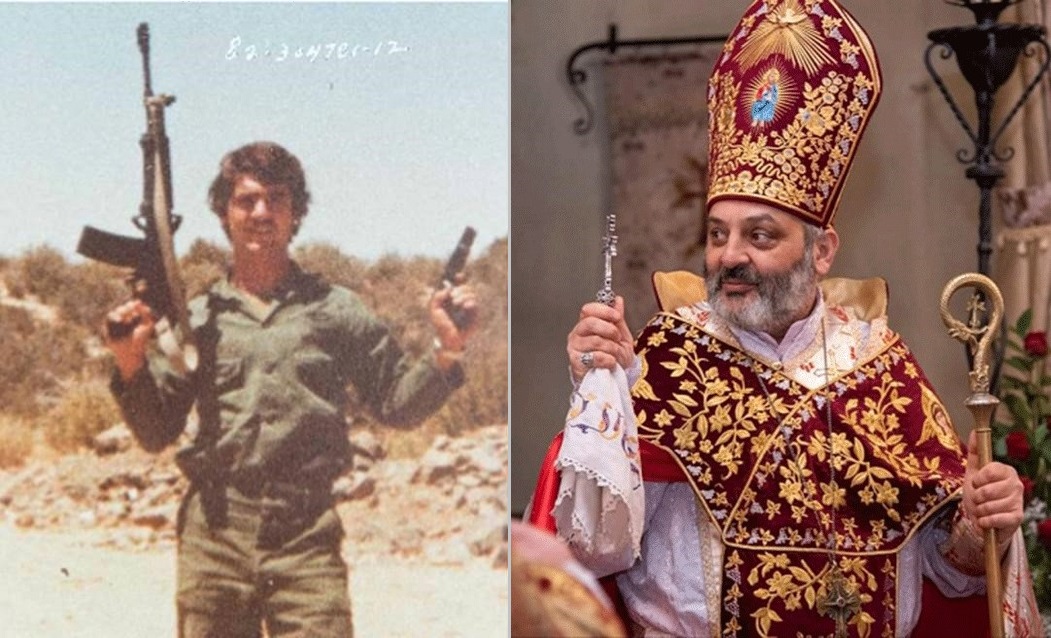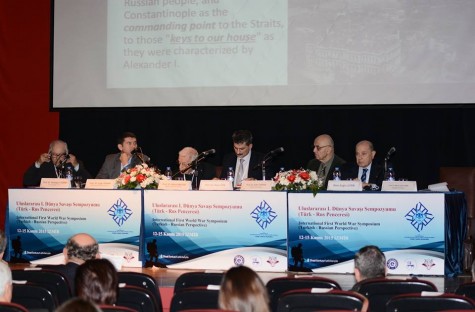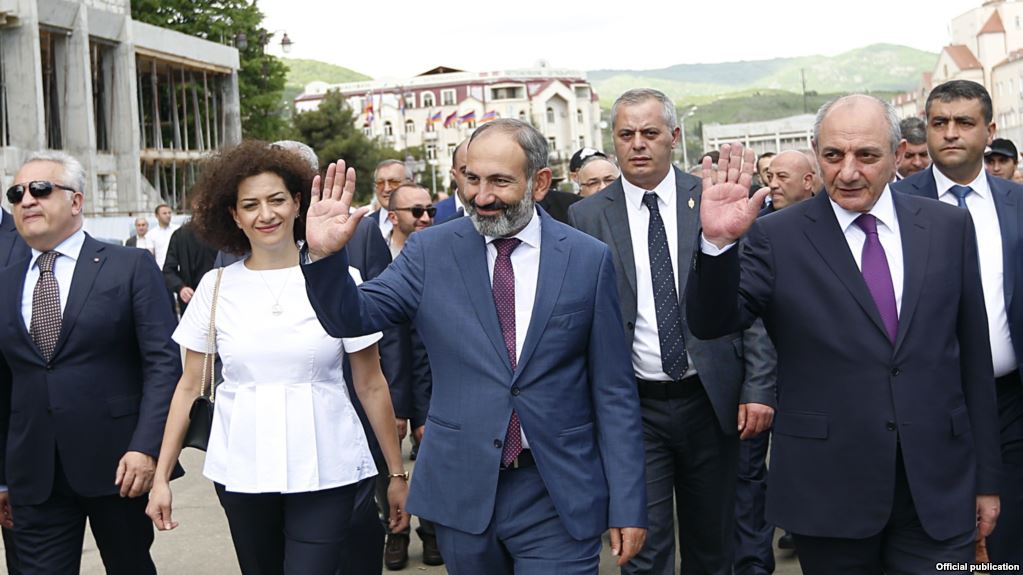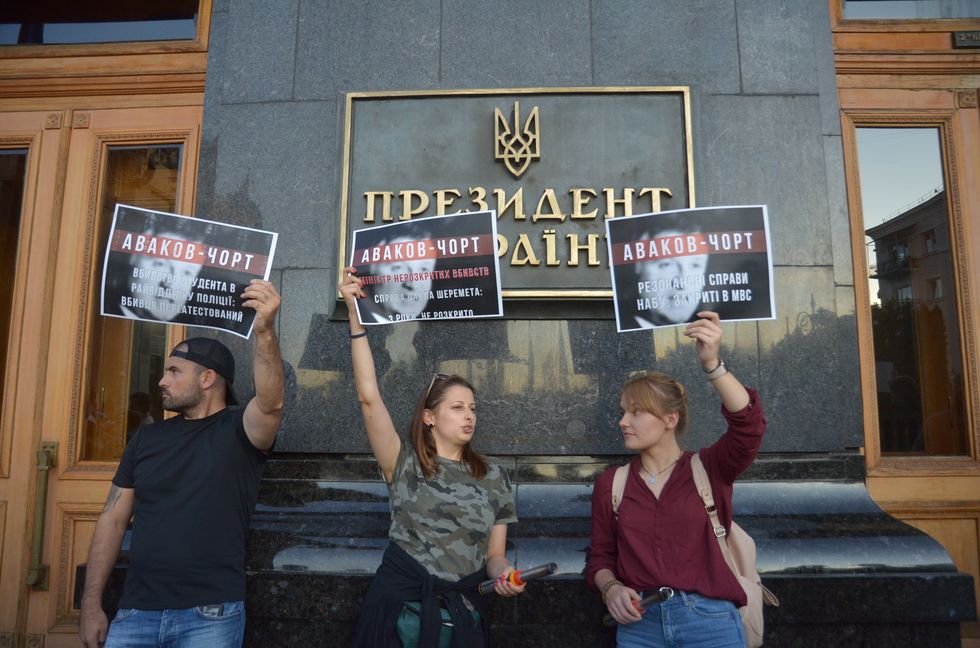
In connection with the normalization process with Azerbaijan and Türkiye, Armenian Prime Minister Nikol Pashinyan is facing a nationalist backlash headed by the clergy and extreme militant groups in Armenia and the Diaspora. Recently, these elements headed by Archbishop Bagrat Galstanyan called for the resignation of the Pashinyan government and the halt of the normalization process with Armenia’s neighbors.
More worryingly, Galstanyan has been seen openly embracing Hampig Sassounian, a convicted terrorist, calling him a “hero” and “justice warrior” in front of the press and the crowd around him. The most disturbing part of this event is the fact that it was done by a leading dignitary of the Armenian Apostolic Church.
On 28 January 1982, Hampig Sassounian, then a 20-year-old Armenian immigrant in Los Angeles, California/the US from Lebanon, assassinated the Turkish Consul General to Los Angeles, Kemal Arıkan and was subsequently sentenced to prison for life without parole. The machinations of the Armenian diaspora and powerful lobbying groups, however, succeeded in getting a parole for the terrorist in 2021 and, as a result, Sassounian left the US for Armenia.
Following the assassination of Turkish Consul-General Kemal Arıkan, the institutions of the Armenian Apostolic Church organized many events in support of Sassounian. Similar events were also held in memory of other Armenian terrorists who were depicted as martyrs.
On 21 October 1983, for example, the Holy Cross Armenian Apostolic Church in Montebello, California, held an “Evening for Hampig.” The evening event was opened by a “Special Church Service” presided over by “His Grace Bishop Yeprem Tabakian, Prelate, Western Prelacy of the Armenian Apostolic Church” in order to show of moral support for Hampig Sassounian.
Likewise, in July 1983, five Armenian terrorists occupied and blew up the Turkish Embassy in Lisbon, Portugal, killing many innocent people and themselves in the course of their wanton terrorist attack. Disturbingly, they were praised and given title of “martyrs” in the Armenian churches across the world. Commemorative services were held in Armenian churches and community centers across the Diaspora, extolling their “heroism” and “sacrifice” for “the Armenian cause.” Here are some examples from the events held in the US:
- 16 October 1983, the A.C.E.C. in Watertown, Massachusetts - a gathering billed as a “Political Rally in memory of the Lisbon Five Martyrs.”
- 21 January 1984, the Armenian All Saints Apostolic Church in Glenview, Illinois - a commemorative service for the “Lisbon Five.”
- 22 January 1984, the Saints Vartanantz Church in Providence, Rhode Island - a commemorative service for the “Lisbon Five.”
- 28 January 1984, the Armenian Community Center in Dearborn, Michigan - a commemorative service for the “Lisbon Five.”
- 29 January 1984, the Saints Vartannantz Church of Ridgefield, New Jersey - a commemorative service for the “Lisbon Five.”
- 12 February 1984, the Soorp Khatch Church in Chevy Chase, Maryland - a commemorative service for the “Lisbon Five.”
It would be no exaggeration to say that the Armenian Church is one of the most influential institutions molding the public opinion among the Armenians both in the Diaspora and in Armenia.
As the pundits of the Armenian history would acknowledge, the Armenian Church throughout the Armenian history has played a very important role in preserving Armenian language, literature, and traditions. Therefore, when the dignitaries of the Armenian Apostolic Church allow and actively participate in events praising and supporting terrorists, the message it sends for the Armenian community and especially for the young Armenians is not only that terrorist acts are officially condoned and allowed by the Church, but also that “terrorism”, when it targets the Turkish people, is a good and praiseworthy act. The moral consequences and contradictions for a church engaging in such reprehensible deeds need no elaborations.
Leaving aside the moral contradictions of a church praising the murder of innocent human beings, the lessons of history clearly show that Armenians who have engaged in terrorism have, throughout the past 150 years, consistently failed to achieve their goals whether in the Russian or Ottoman Empires or in modern Türkiye. Their acts of terror have also ultimately come to haunt and hurt Armenia and the Armenians themselves.
From the very start of the terrorist activities of militant Armenian groups in the 19th century, one can see the presence of men of religion such as priests, bishops, and archbishops among these extremists. The members of the church sometimes organized, directed, or actively participated in the terrorist acts.
During the 1890s, Armenian terrorists engaged in extorting money from the wealthy Armenians in the Ottoman Empire, Russia and the Diaspora. In New York/the US, Armenian merchant Tavşancıyan was repeatedly threatened that he would be killed unless he paid 10,000 dollars to Armenian revolutionary committees and when he refused to contribute the required sum, and he was shot dead by Bedros Hamparsumyan from Harput. Later, in Philadelphia/the US, police also arrested Azmanaz Kazazian and Garabad Narinian for terrorizing and extorting wealthy Armenians for more than 15 years. Under interrogation, Kazazian admitted to the police that he had ambushed and killed 10 Turks as well as an Armenian woman in Marseille, France. The assassinations and money extortions in New York and Philadelphia were directed and organized by the Armenian priest Martougesian
Like Martougesian, in the Caucasus, Bishop Mesrop Ter Movsesian and Archimandrite S. Koriun were involved in extortion of money from Armenians and the assassination of the police and the gendarmerie and the ordinary Armenians who did not obey the instructions of the Dashnaks.
Priests and bishops also played an important role in provoking the clashes in Eastern Anatolia between the Armenians the Muslims. As admitted by Armenian historian Antranig Chalabian, the priests played a leading role in the preparation for the rebellions and terror acts:
“The church leaders of the Duran Bartzravandak had played an important role in organizing the Armenian revolutionary movement. Alongside the 19th century Armenian intellectuals and the lay preachers, the Armenian clergy (Apostolic, Catholic, and Protestant) had, in addition to providing the people with spiritual nourishment and solace, also became apostles of Armenian revolution and protest, instilling the spirit of resistance and rebellion in the soul of the Armenian peasant. Many of them had died with gun in hand, or immolated with their people along the “path” of the battle for freedom. Among them were Bishop Nerses Kharakhanian of Avran, Vartan (Hacobian, Vardan) Vardapet of Aharonk, the chief abbot Hovhannes Vardapet of the St. Apostles Monastery [Arkelots], Ghazar Vardapet of St. Aghbrik, Stepan Vardapet of Gomi Vank, and others.”
Thus, the Church and its dignitaries were instrumental for recruiting and training and hiding Armenian terrorists. Sometimes, they also played a role in storing weapons. In İzmir/the Ottoman Empire, Albert J. Amateau, an American Jew born in the Ottoman Empire, recalled that in 1906 many wealthy Armenians were assassinated by the Armenian terrorists for refusing to give money to the revolutionary committees. Those who did not approve of these committees and feared for their lives complained to the police that the Armenian churches were being used as arms depots. Amateau witnessed “the police raid on that church; and the truck loads of arms and ammunition which were taken out. [I also witnessed] the arrest of five priests and a number of other Armenians who were in the church at the time of the raid.”
Similarly, Bishop Mushegh, “a fanatical terrorist in the guise of a priest” not only condoned the extortion of money and use of assassinations, but also shamelessly tried to justify these acts while branding the rich Armenians as traitors. On the eve of the Adana insurgence of 1909 in the Ottoman Empire, he exhorted Armenians to buy arms, if necessary even by selling their jackets. His provocations played an important part in the intercommunal violence between the Armenians and Muslims of Adana in 1909.
Following the end of the First World War, the French occupied the Çukurova region in southern Anatolia (1918-1921), and during this time, the Armenian Apostolic Church of Sis (today’s Kozan in Adana/Türkiye) played quite a negative role, inciting hatred and violence against the Muslim residents in the Adana region, sabotaging the intercommunal relations between the Muslims and the Armenians, and sowing seeds of enmity. So much so that when the French had to give up their occupation with the Ankara Treaty of 1921, the Apostolic Church of Sis, fearing the consequences of its lamentable actions during the occupation, had to relocate to Antelias, Lebanon in spite of the guarantees provided both by the French and the Ankara Governments. With the ongoing pronouncements, unfortunately Antelias appears not to have changed that mentality.
As these events illustrate, the Armenian church and its dignitaries had played some role in the emergence and condoning of terroristic acts on the part of the Armenian extremists. While the Armenian church had a long history of embracing terrorism, Galstanyan’s actions and speeches indicate that the Church has regrettably not abandoned this reprehensible attitude.
The open and unabashed embrace of terrorism as “heroism” and of a convicted terrorist as a “hero” by an archbishop of the Armenian Apostolic Church should be a cause for alarm, since it means that terrorists are being portrayed for the Armenian youth as role models. As noted, such actions not only fail to attain the results that the Armenian extremists hoped, but also they resulted in tragic consequences for the Armenians.
*Picture: Terrorist Hampig Sassounian (left), Archbishop Bagrat Galstanyan (right)
© 2009-2025 Center for Eurasian Studies (AVİM) All Rights Reserved
No comments yet.
-
 ÇANAKKALE 1915 ORATORIO
ÇANAKKALE 1915 ORATORIO
AVİM 02.04.2015 -
 INTERNATIONAL FIRST WORLD WAR SYMPOSIUM (TURKISH-RUSSIAN PERSPECTIVE) HELD ON 12-15 NOVEMBER 2015
INTERNATIONAL FIRST WORLD WAR SYMPOSIUM (TURKISH-RUSSIAN PERSPECTIVE) HELD ON 12-15 NOVEMBER 2015
AVİM 25.11.2015 -
 2800 YEARS OF ARMENIAN-YEREVAN?
2800 YEARS OF ARMENIAN-YEREVAN?
AVİM 02.03.2018 -
 THE BILL OFFERED BY ARMENIAN LOBBIES TO IMPOSE SANCTIONS AGAINST TURKEY IN CALIFORNIA WAS DENIED BY THE GOVERNOR
THE BILL OFFERED BY ARMENIAN LOBBIES TO IMPOSE SANCTIONS AGAINST TURKEY IN CALIFORNIA WAS DENIED BY THE GOVERNOR
AVİM 15.10.2018 -
 REGIONAL COMPREHENSIVE ECONOMIC AGREEMENT: A SIGNIFICANT TRADE AGREEMENT THAT WILL SHAPE THE REGION AND THE WORLD
REGIONAL COMPREHENSIVE ECONOMIC AGREEMENT: A SIGNIFICANT TRADE AGREEMENT THAT WILL SHAPE THE REGION AND THE WORLD
AVİM 02.12.2020
-
 ARMENIA’S PRIME MINISTER HAS CHANGED BUT THE LANGUAGE IS THE SAME
ARMENIA’S PRIME MINISTER HAS CHANGED BUT THE LANGUAGE IS THE SAME
Tutku DİLAVER 17.05.2018 -
 THE ‘ARMENIAN QUESTION’ IN UKRAINE - II: THE ADVOCATES OF THE ‘ARMENIAN CAUSE’ IN UKRAINE
THE ‘ARMENIAN QUESTION’ IN UKRAINE - II: THE ADVOCATES OF THE ‘ARMENIAN CAUSE’ IN UKRAINE
Turgut Kerem TUNCEL 10.05.2021 -
 THE EUROPEAN PARLIAMENT AND ITS RESOLUTION ON THE 2015 PROGRESS REPORT ON TURKEY
THE EUROPEAN PARLIAMENT AND ITS RESOLUTION ON THE 2015 PROGRESS REPORT ON TURKEY
Ali Murat TAŞKENT 20.04.2016 -
DIASPORA ARMENIANS AND THEIR INITIATIVES FOR COMPENSATION: THE REFLECTIONS OF THE MOVSESIAN CASE II
Aslan Yavuz ŞİR 29.02.2012 -
 EURASIAN DEMOGRAPHY’S TURNING POINT: WHY TURKIC STATES MUST LEAD ON ELDERLY RIGHTS
EURASIAN DEMOGRAPHY’S TURNING POINT: WHY TURKIC STATES MUST LEAD ON ELDERLY RIGHTS
Teoman Ertuğrul TULUN 21.11.2025
-
25.01.2016
THE ARMENIAN QUESTION - BASIC KNOWLEDGE AND DOCUMENTATION -
12.06.2024
THE TRUTH WILL OUT -
27.03.2023
RADİKAL ERMENİ UNSURLARCA GERÇEKLEŞTİRİLEN MEZALİMLER VE VANDALİZM -
17.03.2023
PATRIOTISM PERVERTED -
23.02.2023
MEN ARE LIKE THAT -
03.02.2023
BAKÜ-TİFLİS-CEYHAN BORU HATTININ YAŞANAN TARİHİ -
16.12.2022
INTERNATIONAL SCHOLARS ON THE EVENTS OF 1915 -
07.12.2022
FAKE PHOTOS AND THE ARMENIAN PROPAGANDA -
07.12.2022
ERMENİ PROPAGANDASI VE SAHTE RESİMLER -
01.01.2022
A Letter From Japan - Strategically Mum: The Silence of the Armenians -
01.01.2022
Japonya'dan Bir Mektup - Stratejik Suskunluk: Ermenilerin Sessizliği -
03.06.2020
Anastas Mikoyan: Confessions of an Armenian Bolshevik -
08.04.2020
Sovyet Sonrası Ukrayna’da Devlet, Toplum ve Siyaset - Değişen Dinamikler, Dönüşen Kimlikler -
12.06.2018
Ermeni Sorunuyla İlgili İngiliz Belgeleri (1912-1923) - British Documents on Armenian Question (1912-1923) -
02.12.2016
Turkish-Russian Academics: A Historical Study on the Caucasus -
01.07.2016
Gürcistan'daki Müslüman Topluluklar: Azınlık Hakları, Kimlik, Siyaset -
10.03.2016
Armenian Diaspora: Diaspora, State and the Imagination of the Republic of Armenia -
24.01.2016
ERMENİ SORUNU - TEMEL BİLGİ VE BELGELER (2. BASKI)
-
AVİM Conference Hall 24.01.2023
CONFERENCE TITLED “HUNGARY’S PERSPECTIVES ON THE TURKIC WORLD"









